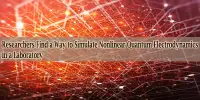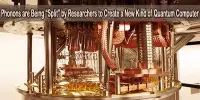Fusion produces energy by fusing light elements into plasma. Scientists all over the world are working to replicate the fusion process in order to provide a safe, clean, and abundant power source for generating electricity. Tokamaks are doughnut-shaped devices that use magnetic fields to confine the plasma. The problem with developing plasma in such devices, however, is figuring out how to solve the equation that describes the motion of free-wheeling electrons as they collide and bounce around.
Path-setting method for simulating the crazy-quilt movement of free electrons during experimental efforts to harness the fusion power that powers the sun and stars on Earth. The method solves a complex equation, allowing for better control of the random and fast-moving electrons in fusion energy fuel.
Researchers at the U.S. Department of Energy’s (DOE) Princeton Plasma Physics Laboratory have developed an efficient computational method for simulating the erratic movement of free electrons during experimental efforts to harness the fusion power that powers the sun and stars on Earth. The method solves a complex equation, allowing for better control of the random and fast-moving electrons in fusion energy fuel.
Solving the stochastic differential equation gives the probability of every path the scattered electrons can take. Such equations produce a pattern that can be statistically analyzed but not precisely determined.
Yichen Fu
Fusion generates enormous amounts of energy by combining light elements in the form of plasma, which is a hot, charged gas composed of free electrons and atomic nuclei, or ions, that account for 99 percent of the visible universe. Scientists all over the world are attempting to replicate the fusion process in order to provide a safe, clean, and abundant power source for generating electricity.
Solving the equation
Solving the equation that describes the motion of free-wheeling electrons as they collide and bounce around has been a major challenge for researchers developing fusion on doughnut-shaped devices called tokamaks, which confine the plasma in magnetic fields. Due to the complexity of the equation, standard methods for simulating this motion, known technically as pitch-angle scattering, have proven ineffective.
A successful set of computational rules, or algorithms, would solve the equation while preserving the speeding particles’ energy. “Solving the stochastic differential equation gives the probability of every path the scattered electrons can take,” said Yichen Fu, a graduate student in PPPL’s Princeton Program in Plasma Physics and lead author of a paper proposing a solution in the Journal of Computational Physics. Such equations produce a pattern that can be statistically analyzed but not precisely determined.

The precise solution describes the electron scattering trajectories. “However, the trajectories are probabilistic, and we don’t know where the electrons will go because there are so many possible paths,” Fu explained. “However, by solving the trajectories, we can know the probability of electrons choosing each path, and knowing that allows for more accurate simulations, which can lead to better plasma control.”
The improved guidance for fusion researchers who pump electric current into tokamak plasmas to create the magnetic field that confines the superhot gas is a significant benefit of this knowledge. Another advantage is a better understanding of the pitch-angle scattering on energetic runaway electrons that threaten fusion devices.
Rigorous proof
The discovery establishes a rigorous mathematical proof of the first working algorithm for solving the complex equation. “This gives experimentalists a better theoretical description of what’s going on to help them design their experiments,” said Hong Qin, a principal research physicist, Fu’s advisor, and paper coauthor. “Previously, there was no working algorithm for this equation, so physicists worked around the problem by changing the equation.”
The reported study represents the recently launched Computational Sciences Department (CSD) at PPPL’s research activity in algorithms and applied math, and it expands on an earlier paper coauthored by Fu, Qin, and graduate student Laura Xin Zhang, who is also a co-author of this paper. While that research produced a novel energy-saving algorithm for tracking fast particles, it did not include magnetic fields and the mathematical accuracy was not rigorously proven.
The CSD, which was established this year as part of the Lab’s transformation into a multi-purpose research facility, supports PPPL’s critical fusion energy sciences mission and serves as a home for computationally intensive discoveries. “This technological advancement demonstrates the CSD’s role,” Qin said. “One of its objectives is to create algorithms that will lead to better fusion simulations.”
While that research produced a novel energy-saving algorithm for tracking fast particles, it did not include magnetic fields and the mathematical accuracy was not rigorously proven.
















